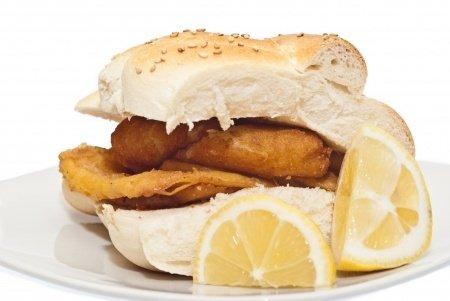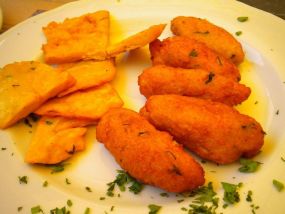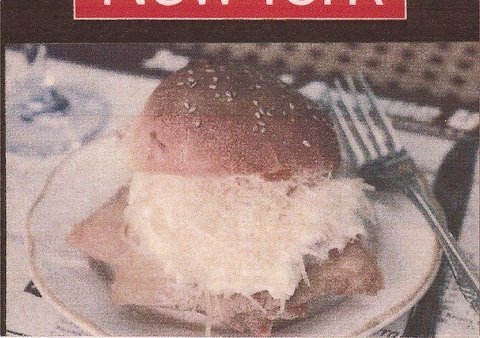
Chick Peas Fritters
( Panelle )
When I lived in Palermo, the panellari (the makers and sellers of panelli) were a local institution. In my hometown, this trade is patronized almost by everyone, by the rich and the poor, by the college professor and the handyman. In the old days, the panellari were located only within the city limits of Palermo. They were situated in strategic sites in every neighborhood and ready to do business early in the morning.
The shop consisted of a small storefront with a window on the street, and inside, there was enough room for a big cauldron with boiling oil, a counter to make the panelle and a perforated aluminum pan to hold and drain the excess oil from the panelle and to rest the ravaccine, the skimmers. They made and sold panelle, potato croquettes, and rascature, which were made of thick chickpea dough that had become too hard to make panelle.
In season, they cooked i fedde, fried sliced eggplants, and quaglie, quails, a small fried eggplant partially cut into lengthwise sticks less than 1 inch thick and held together by the uncut top of the eggplant. With a little imagination, the fried quaglie, when they opened out, looked like a quail’s feathers or a fan. As you will realize from the recipe that follows, the panelle are simple and easy to make.
The ingredients are chickpea flour, salt and water. It may seem spare, but a treat made of fresh soft bread stuffed with panelle can be a delightful breakfast or a delicious lunch, as was the custom of every family in Palermo. When I was going to elementary and high school, I bought pane e panelle from a stand parked near my school; it became my preferred snack for its taste and because of the reasonable price, which coincided with my limited finances. My family’s preferred two panelli stores: one located at La Vucciria and Giacomino located in Via Alloro. Panelli can be bought in shops located on every corner of the city.
Today, the panelle are made all over Sicily and are served as an appetizer.
In the United States, the panelle were introduced around 1910 by the owner of La Focacceria on First Avenue in Manhattan, and in Brooklyn, around 1920 by Mr. Paul Benfante, who opened a shop on Degraw Street; a few years later he moved his shop to Union Street and Hicks Street. When cooking at Joe’s of Avenue U, in Brooklyn, we prepared panelle, among other Sicilian specialties, and people from the five boroughs and nearby towns came to buy them. We produced them in large quantities and frequently sold out all we had prepared for the day.


The “Panelle Special”
At our Focacceria, on Avenue U in Brooklyn, we served the Panelle Special: a delicious sandwich made in a soft roll stuffed with panelle, covered with ricotta and cheese and lightly toasted.

The Panelle Molds
The traditional molds to make panelle are made of wood rectangles 2 ½ inches by 4 inches by ¾ inch thick. The preferred wood is beech pine because it is solid and heavy, but maple or birch could be used. I am enclosing a picture of molds that we made a few years ago at Joe’s of Avenue U “La Focacceria Palermitana” in Brooklyn, NY.
The molds are made of maple, using a plank 2 13/16 inches wide and ¾ of an inch thick. We cut it into 4-inch pieces and had a friend, who was an amateur woodworker, apply the engraving as per the photo. The engraving is not essential to the finality of the molds. The type of wood used is very important, as it would prevent chipping and the splintering or flaking of the wood into the panelle.

- Yield20 to 40 Panelle
- Sicilian DelicaciesChick Peas Fritters - Panelle
Ingredients
To make about 40 panelle using the traditional molds (or 12 panelle using 7 ¼-inch dessert dishes)
- 1 lb sifted chickpea flour
1 quart + 1 cup water
½ teaspoon salt
To make about 20 panelle using the traditional molds (or 6 panelle using 7 ¼-inch dessert dishes)
- 1 cup of chickpea flour
1 ½ cups water
Pinch of salt
Instructions
THE COOKING OF THE CHICKPEAS
In a 4-quart saucepan, combine the water, chickpea flour and salt. Using a whisk, mix until smooth and without lumps. Over medium heat, bring to a boil, mixing continuously. Lower the heat when mixture starts to bubble, stirring continuously and cooking for about 10 minutes, until you get a semi-solid and homogeneous mixture. Do not leave pot unattended and stir continuously. To enhance and give a different dimension to the panelle, add chopped parsley and/or black peppers before removing pan from the stove.
MAKING THE PANELLE
Remove pot from the heat and smear the mixture on the traditional molds, made of wood rectangles 2 ½ inches by 4 inches by ¾ inch thick. When mixture has cooled, detach from the molds. Molds must be soaked in water overnight. If you do not have the wooden molds, pour mixture on top of a clean and wet marble or Formica countertop, spread it to less than a quarter of an inch thick and when it has cooled, cut into triangular or square shapes. Dessert dishes (7 ¼-inch dishes) can be used by spreading the mixture, and when the panelle cool off, cut each piece into four.
THE FRYING
Over medium heat, pour ½ cup of oil into a 12-inch skillet, heat oil to 375F and before it starts to smoke, cook the panelle as you would fry cutlets. When it turns a golden color on one side, turn and cook the other side. Place panelle on paper towels to drain.
SERVE HOT!
